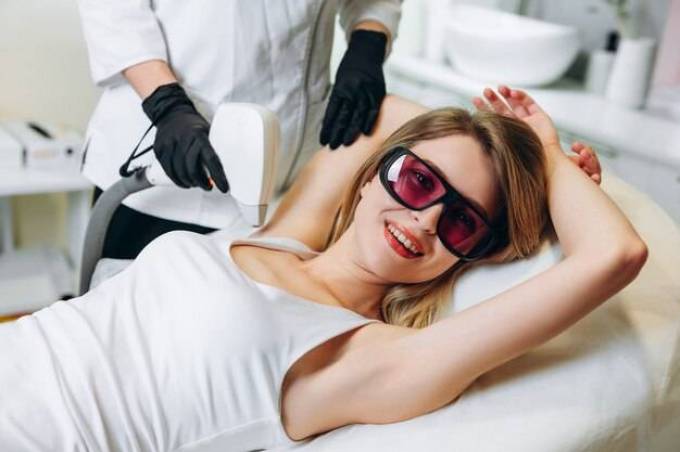Full Body Laser Hair Removal: Painless and Effective?
Published By Dynamic Aesthetic Clinic, 12 Sep 2024

In the quest for smooth, hair-free skin, full body laser hair removal has emerged as a popular and effective solution. This comprehensive treatment targets multiple areas of the body in a single session, offering a long-term reduction in hair growth. But is it truly painless and effective? This article delves into the benefits, procedure, pain management, effectiveness, and aftercare of full body Laser Hair Removal in Dubai to help you make an informed decision.
What is Full Body Laser Hair Removal?
Comprehensive Treatment
Full body laser hair removal involves treating various areas of the body in one session. Commonly targeted areas include the legs, arms, underarms, bikini line, back, chest, and face. This approach is ideal for individuals looking to reduce hair growth across large or multiple regions efficiently.
How It Works
Laser hair removal uses concentrated light beams to target the pigment (melanin) in hair follicles. The light energy heats and damages the follicle, inhibiting future hair growth. Since hair grows in cycles, multiple sessions are required to achieve optimal results, as the laser is most effective during the active growth phase.
Benefits of Full Body Laser Hair Removal
Long-Term Hair Reduction
One of the primary advantages of laser hair removal is its long-term efficacy. Unlike temporary methods such as shaving or waxing, laser treatments can significantly reduce hair growth, leading to smoother skin for extended periods.
Time and Cost Efficiency
While the initial cost of full body laser hair removal may seem high, it can be more cost-effective in the long run compared to the cumulative expenses of regular waxing, shaving, or other temporary hair removal methods. Additionally, treating multiple areas in one session saves time.
Precision and Speed
Laser hair removal offers precision, targeting dark, coarse hairs while leaving the surrounding skin undamaged. Each laser pulse takes a fraction of a second and can treat multiple hairs simultaneously, making the process relatively quick.
The Procedure
Pre-Treatment Preparation
Proper preparation is crucial for effective laser hair removal. This includes:
- Avoiding Sun Exposure: Stay out of the sun for at least two weeks before the appointment.
- Shaving: Shave the treatment areas 24 to 48 hours prior to the session.
- Avoiding Other Hair Removal Methods: Do not wax, pluck, or thread for at least four to six weeks before treatment.
- Avoiding Certain Skincare Products: Refrain from using retinoids and chemical peels for at least one week before the session.
During the Session
During the procedure, you will be provided with protective eyewear to shield your eyes from the laser light. The practitioner will apply a cooling gel or use a device with a cooling tip to minimize discomfort. The laser device will then be adjusted based on your skin type, hair color, and the area being treated.
Pain Management
While laser hair removal is often described as less painful than waxing, the sensation can vary depending on individual pain tolerance and the area being treated. Most people describe the feeling as a mild stinging or snapping sensation, similar to the snap of a rubber band against the skin.
Pain Reduction Techniques
- Cooling Gel or Device: A cooling gel or a device with a cooling tip can be applied to the skin to reduce discomfort.
- Topical Anesthetics: In some cases, a topical anesthetic cream may be applied to numb the treatment area.
- Pain Relievers: Over-the-counter pain relievers, such as ibuprofen, can be taken before the session to help manage discomfort.
Effectiveness
Factors Influencing Effectiveness
Several factors can influence the effectiveness of laser hair removal:
- Hair Color and Skin Type: The laser targets melanin, making it most effective on dark hair and light skin. However, advancements in technology have made it possible to treat a wider range of skin tones and hair colors.
- Hair Growth Cycle: Hair grows in cycles, and the laser is most effective during the active growth phase. Multiple sessions are needed to target all hairs during this phase.
- Treatment Consistency: Adhering to the recommended treatment schedule is crucial for achieving the best results.
Expected Results
Most individuals experience a significant reduction in hair growth after a series of treatments. While some hair may regrow, it is usually finer and lighter. Maintenance sessions may be required to sustain the results.
Aftercare
Immediate Aftercare
After the procedure, the treated areas may appear red and swollen, similar to a mild sunburn. Applying a cool compress and using aloe vera gel can help soothe the skin.
Long-Term Care
- Avoid Sun Exposure: Protect the treated areas from sun exposure and use a high-SPF sunscreen.
- Gentle Skincare: Use mild, fragrance-free cleansers and moisturizers to avoid irritation.
- Avoid Heat: Refrain from hot showers, saunas, and strenuous exercise for at least 24 to 48 hours post-treatment.
Follow-Up Appointments
Scheduling follow-up appointments as recommended by your practitioner is essential for achieving and maintaining optimal results. The number of sessions required varies based on individual factors, but most people need six to eight sessions for significant hair reduction.
Conclusion!
Full body laser hair removal offers a comprehensive, long-term solution for those seeking to reduce unwanted hair across multiple areas. While the procedure may involve some discomfort, advancements in technology and pain management techniques have made it more tolerable. The effectiveness of laser hair removal depends on various factors, including hair color, skin type, and adherence to the treatment schedule. With proper preparation, aftercare, and consistent follow-up sessions, full body laser hair removal can provide smooth, hair-free skin and a significant reduction in hair growth. Always consult with a qualified practitioner to determine if this treatment is right for you and to ensure the best possible results.
